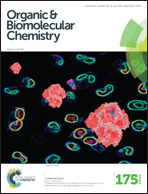Quinolone-1-(2H)-ones as hedgehog signalling pathway inhibitors†
Abstract
A series of quinolone-2-(1H)-ones derived from the Ugi-Knoevenagel three- and four-component reaction were prepared exhibiting low micromolar cytotoxicity against a panel of eight human cancer cell lines known to possess the Hedgehog Signalling Pathway (HSP) components, as well as the seminoma TCAM-2 cell line. A focused SAR study was conducted and revealed core characteristics of the quinolone-2-(1H)-ones required for cytotoxicity. These requirements included a C3-tethered indole moiety, an indole C5-methyl moiety, an aliphatic tail or an ester, as well as an additional aromatic moiety. Further investigation in the SAG-activated Shh-LIGHT2 cell line with the most active analogues: 2-(3-cyano-2-oxo-4-phenylquinolin-1(2H)-yl)-2-(1-methyl-1H-indol-3-yl)-N-(pentan-2-yl)acetamide (5), 2-(3-cyano-2-oxo-4-phenylquinolin-1(2H)-yl)-2-(5-methyl-1H-indol-3-yl)-N-(pentan-2-yl)acetamide (23) and ethyl (2-(3-cyano-2-oxo-4-phenylquinolin-1(2H)-yl)-2-(5-methyl-1H-indol-3-yl)acetyl)glycinate (24) demonstrated a down regulation of the HSP via a reduction in Gli expression, and in the mRNA levels of Ptch1 and Gli2. Analogues 5, 23 and 24 returned in cell inhibition values of 11.6, 2.9 and 3.1 μM, respectively, making this new HSP-inhibitor pharmacophore amongst the most potent non-Smo targeted inhibitors thus far reported.



 Please wait while we load your content...
Please wait while we load your content...